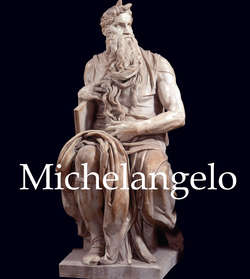Читать книгу Michelangelo - Eugène Müntz - Страница 3
Biography
Оглавление1475: Born on March 6th in Caprese, Tuscany, second child to Lodovico di Leonardo Buonarroti Simoni and Francesca di Neri di Miniato del Sera.
1481: Enrollment Francesco da Urbino's Latin school following his mother's death.
1483: Birth of rival Raphael Sanzio in Urbino.
1484: Start of a three-year apprenticeship under Domenico Ghirlandaio.
1485: Stays with Bertoldo in the Medici gardens near San Marco, where he studies its ancient and contemporary works of sculpture.
1486: Death of Lorenzo de Medici; completion of Battle of the (Lapiths and) Centaurs, Madonna of the Stairs (a.k.a. Madonna of the Steps), and a wooden crucifix for Santo Spirito in Florence.
1487: Flight to Venice and Bologna as the armies of Charles VIII threaten to take over Florence and rumours predict the imminent fall of the Medici.
1488: Arrival in Rome to become a protégé of Jacopo Galli, who commissions his Bacchus; completion of Sleeping Cupid, now lost.
1489: Commission from Cardinal Jean de la Grolaye de Villiers for the Rome Pietà.
1490: Death of Cardinal Bilhères shortly after completion of the Rome Pietà.
1491: Altarpiece for Sant'Agostino in Rome, as King Louis XII of France invades Italy.
1492: Return to Florence and commission for David in marble.
1493: Commission for statues of the Twelve Apostles slated for the Cathedral Dome in Florence – only sketches for St. Matthew were ever completed; death of the 25-day Pope Pius III; election of Pope Julius II; commission for the Bruges Madonna; completion of Taddei Tondo and Pitti Tondo.
1494: Completion and inauguration of David at Piazza dei Signori; portfolio work for Battle of Cascina.
1495: Commission from Pope Julius II for his tomb in Rome and the start of stormy relations with the Vatican; subsequent stay in Carrara to secure the marble needed.
1496: Return to Florence.
1497: Execution of Doni Tondo for Agnolo Doni (possibly completed within 1503 to 1505).
1498: Arrival in Rome to paint the Sistine ceiling.
1499: Start of decoration work for the Stanze of the Vatican, concurrent with the Sistine worksite.
1512: Unveiling of the new Sistine ceiling.
1513: Death of Pope Julius II and election of Pope Leo X, son of Lorenzo de Medici; renegotiation of the contract for the tomb of Pope Julius II.
1515: Pope Leo X dubs Michelangelo Count Palatino.
1516: Return to Florence; commission from Pope Leo X for the façade of San Lorenzo there.
1520: First drawings for the Medici Chapel.
1521: Death of Pope Leo X (Giovanni de Medici) and election of Pope Hadrian VI; Michelangelo receives no Vatican commissions and works on the Medici family tombs.
1523: Election of Pope Clement VII (Giulio de Medici).
1524: Start of Dusk and Dawn for the tomb of Lorenzo de Medici, and a commission for the Laurentian Library.
1527: Sacking of Rome; flight of the Medici.
1528: Almost one year of army engineering, urban planning and architecture to defend Florence from the Medici.
1529: Appointment as army engineer in the Nove della Milizia, the nine-man military leadership of the Florentine armed forces.
1530: The Medici retake Florence; commission from the Duke of Ferrara for Leda and the Swan – highly acclaimed and now lost; execution work on the Medici chapel.
1531: Noli me Tangere portfolio.
1534: Final goodbye to Florence; death of Pope Clement VII and election of Pope Paul III who commissions Last Judgment; permanent residence in Rome.
1536: Start of Last Judgment for the Sistine Chapel.
1538: Completion of working drawings to install the statue of Marcus Aurelius in Campidoglio.
1541: Inauguration of the Last Judgment.
1542: Worksite start-up for the Pauline Chapel.
1545: Completion of the tomb for Pope Julius II, one of Michelangelo's most time-consuming achievements.
1546: Appointment as chief architect to St. Peter's in Rome; work on St. Peter's and the Farnese Palace.
1547: Death of Vittoria Colonna, longtime friend and accomplished poetess, whom he met while working on the Last Judgment.
1549: Death of Pope Paul III and election of Pope Julius III; reconfirmation of the artist's commissions.
1550: Completion of the Pauline Chapel frescoes; start of the Florentine Pietà.
1552: Completion of the Capitoline stair.
1555: Death of Pope Julius III, followed by Pope Marcel II and Pope Paul IV; reconfirmation of his appointment as chief architect of St. Peters.
1556: Flight to Spoleta from Rome, now under threat from the Spanish Army.
1560: Drawings commissioned by Catherine de Medici to glorify her husband, King Henry II of France; design of a tomb for Giangiacomo de Medici di Marignano and drawings for the Porta Pia – a hectic year.
1563: Appointment by Cosimo de Medici as “head” of his newly-founded Accademia in Florence.
1564: Council of Trent orders moralistic touch-ups to the Last Judgment; dies at home in Macel de Corvi three weeks later on February 18, 1564 of a “slow fever”, as Vasari tells us.
* * *
